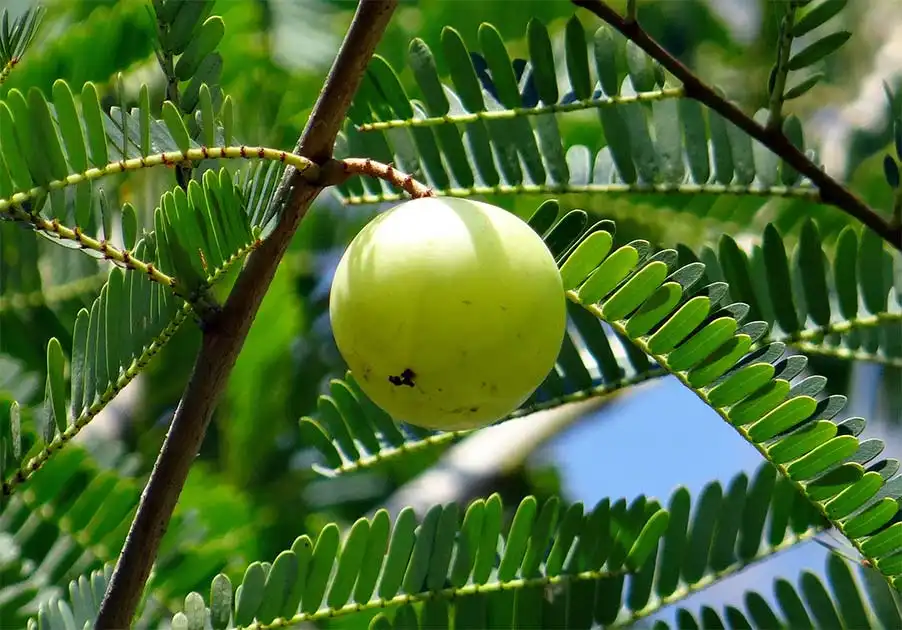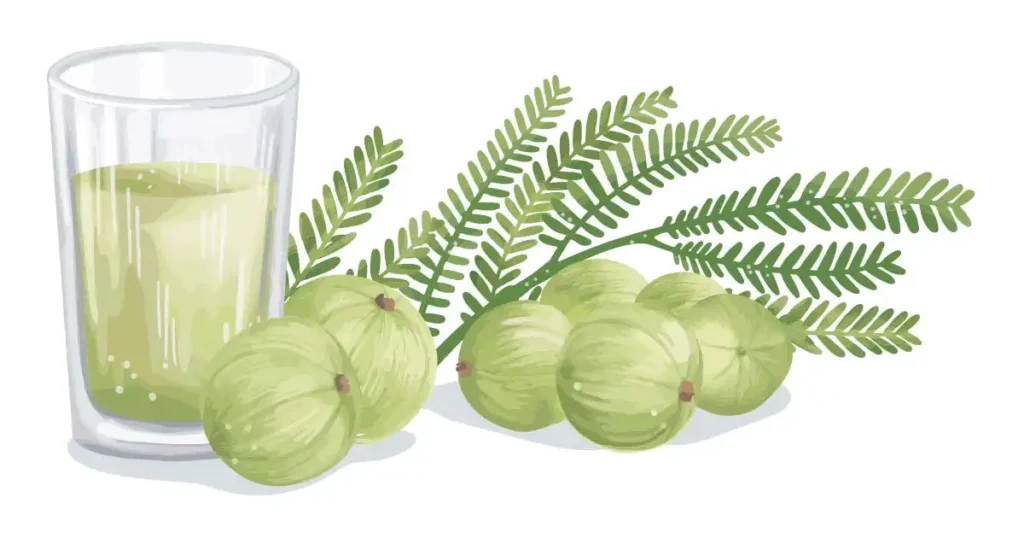Amla, the Indian gooseberry (Emblica Officinalis) is the fruit or berries of the Indian gooseberry tree that are beneficial in ayurvedic medicine due to their high nutritive values. The small yellowish-green and round amla berries are a powerhouse of polyphenols, tannins, ellagic acid, Vitamin C, and many more antioxidants and phytonutrients. No wonder, Indian gooseberry or amla is referred to as a superfood.
An essential characteristic of Amla per Ayurveda is the various tastes of Amla like pungent, sweet, bitter, sour, and other tastes. Nevertheless, amla has a sour taste and is described as a nurturing herb in Ayurveda, which improves the health and well-being of the body and the mind. Amla is a wellness health herb known as a Divyaushada-that means divine medicine.

Amla Phytoconstituents
Amla fruit is known to improve wellness health and has immense physical health benefits. This is attributed to its composition, rich in phytonutrients such as:
- Vitamin C
- Carotene
- Ellagic acid
- Gallic acid
- Apigenin
- Quercetin
- Luteolin
- And corilagin.
Amla: Reservoir of Health-Enhancing Phytonutrients
If you have been wondering and asking yourself- “How can I optimize my physical health”, then, Amla may be the answer. Taking Amla in some form or another can immensely help you achieve optimum physical health. Every 100 g of Amla powder contains:
- Carbohydrates: 10 g
- Protein: 0.80 g
- Fat: 0.50g
- Tota calories: 44 KCal
- Fiber: 4.3Kcal
- Fiber: 4.3g
- Magnesium: 10mg
- Calcium: 25mg
- Iron: 0.31mg
- Zinc: 0.12 mg
- Potassium: 198 mg

10 Physical Health Benefits of Amla
In a clinical study, Amla (Indian Gooseberry) was shown to have a lipid-lowering action in patients between 35 and 55 years. Post-administration of 500 mg of amla capsules to patients for more than 42 days. After 28 days, the subjects had a better blood profile with a lowering of TC, TG, LDL, and a higher HDL.
Amla fruit can provide various medicinal and health benefits. It can be taken as a whole fruit or naturally processed powder. If you choose to take fruit, take only 1-2 fruits daily. When you take it in a powder supplement, it is recommended to take ¼- ½ teaspoon twice a day.
Here is an overview of certain benefits of Amla:
1. Amla May Prove Helpful in Controlling Hypertension
Amla, Indian gooseberry is highly rich in antioxidants, which scavenge the free radicals the human body produces during stressful situations. Amla has a significant amount of potassium, which helps regulate fluctuations in blood pressure. It is helpful for patients having various kinds of blood pressure problems. In addition, potassium helps dilate blood vessels, which improves blood circulation and regulates blood pressure. Drinking Amla juice can prove helpful in blood pressure regulation. However, this is general information. It is important to get a medical consultation and follow the treatment plan given by your healthcare professional for your condition.

2. Amla May Be Helpful in Diabetes
Amla is considered an effective home remedy for diabetes. An important reason why Amla is helpful in diabetes is that it has a high amount of Vitamin C content. Moreover, the fruit’s phytonutrients help lower oxidative stress due to free radical generation. Therefore, regular consumption of Amla, Indian Gooseberry obtained from fresh resources helps prevent diabetes. In addition, Amla, with its high fiber content, may prove helpful in regulating blood sugar levels. Therefore, it makes perfect sense to include Amla in your diet plan for diabetes management. This is general information. Make sure, you take the herb under medical supervision, especially if you experience high fluctuations in blood sugar levels. It is important to get a medical consultation and follow the treatment plan given by your healthcare professional for your condition.
3. Amla Can Enhance the Digestive Power of Gut

Amla or gooseberry have an ample amount of soluble dietary fibers that help to regulate bowel movements. This can prove helpful for relieving irritable bowel syndrome. In addition, a higher amount of vitamin C helps to absorb many other essential minerals that again improve the digestive and absorptive powers of the gut. However, this is general information. It is important to get a medical consultation and follow the treatment plan given by your healthcare professional for your condition.
4. Amla May Prove Helpful in Diarrhoea
Amla has astringent constituents, which help to relax the excessive obstruction and expansion of the muscles in abdominal pain. It is used to manage bloody diarrhea (dysentery). Amla certainly can help in relieving diarrhea and abdominal pain. However, this is general information. It is important to get a medical consultation and follow the treatment plan for diarrhea treatment given by your healthcare professional for your condition.
Did You Know?
Boiling 5-6 cleaned and washed fresh guava leaves in 200mL (around a cup) water for 4-5 minutes gives an aqueous extract, that can help regulate diarrhea. This phytonutrients extract taken 3-4 times a day can help give significant relief in diarrhea. However, this is general information. It is important to get a medical consultation for diarrhea treatment given by your healthcare professional for your condition. You can use this extract as a support for faster relief.
4. Amla May Help Promote Mental Health
Amla berries have a great ability to quench antioxidants, thus they have neuroprotective effects. Moreover, in Ayurveda, Amla, Indian gooseberry is known to have memory-enhancing effects. Therefore, Amla is considered included in the treatment of dementia patients in certain Ayurveda treatments. However, this is general information. It is important to get a medical consultation for dementia or any other mental health condition and follow the right treatment plan.
5. Amla May Help in Healthy Weight Loss and Management
A slow metabolism can result in fat accumulation. Moreover, irregular eating habits can result in fat formation in the wrong places. Amla is also helpful in pushing out toxins from the body. For weight loss, consider taking raw Amla fruit or Amla powder. You can also include Amla candies with lukewarm water. However, this is general information. It is important to get a medical consultation and follow the treatment plan given by your healthcare professional for your condition.
6. Amla May Help Promote Hair Health

Ayurveda recognizes Amla for its pitta ameliorating effect. Amla oil is also a long-time home remedy for enhancing hair growth. Applying a mixture of Amla extra in coconut oil helps stimulate hair follicles for enhanced hair growth. Amla, Indian gooseberry helps in improving the volume, density, and length of the hair. Amla oil is also considered useful to lower hair fall. It also helps to increase hair growth. Amla is also effective against free radicals that lead to premature greying hair. Thus, amla or gooseberry extracts can act as a highly effective hair tonic.
Amla fruit has a lot of vitamin C, which can help increase collagen levels. It will surely impact new hair growth and lead to more new hair. In addition, Amla has scalp-hydrating properties and proves helpful in preventing dandruff issues. Traditionally, amla fruit extracts are incorporated into oils to formulate amla hair oil, which is considered to improve hair health.
Vitamin C in amla has potent anti-inflammatory and antibacterial properties that protect the scalp from itchiness and irritation due to infection and inflammation. Amla, due to its cooling effect can also prove helpful in preventing premature greying of hair.
Did You Know?
An aqueous chlorophyll extract made by boiling fresh leaves of bhringraj, peepal, and ashwagandha, and mixing some amla powder into it is a hair tonic. Some herbal therapy specialists say such freshly prepared extract, when consumed for 3 months regularly may even show effective results in halting premature greying of hair. This, they attribute to the power of chlorophyll. However, this is general information. If you want to seek treatment for premature grey hair, make sure you seek professional medical advice for your particular condition.
7. Amla May Promote Healthier Eyes

Amla is a top-class vitamin A source. This is the vitamin that improves eye health. Amla berries containing Vitamin A help improve vision. Furthermore, Amla consumption improves immunity and is known to lower the risk of conjunctivitis. Due to cooling properties, amla is traditionally considered eye-protective. It may prove helpful in preventing macular degeneration due to the aging process. However, this is general information. It is important to get a medical consultation and follow the treatment plan given by your healthcare professional for your condition.
8. Amla and Polycystic Ovary Syndrome
In Ayurveda, Amla is an important wellness health herb. It is a general tonic and may also help in mitigating PCOS in women. Amla fruit due to its richness of Vitamin C and antioxidants is also helpful in removing toxins from the body. Additionally, amla has been traditionally consumed in India to help maintain a healthy menstrual cycle and hormonal balance. It can help in improving fertility in women. However, this is general information. It is important to get a medical consultation and follow the treatment plan given by your healthcare professional for your condition.
10. Amla May Enhance Skin Health and Delay Aging
Amla, due to its antioxidant properties, is a natural blood purifier. Therefore, a regular amla intake helps in increasing skin glow. Moreover, Amla consumption is also helpful for taking care of various skin-related allergies. However, this is general information. It is important to get a medical consultation and follow the treatment plan given by your healthcare professional for your condition. Certain research also suggests amla tracts have anti-aging properties.
Amla Products: How To Use Amla?
Amla dosage can be different due to the source of the Amla fruit. Typically, the dosage is mentioned on the label in its various forms, like powder, capsules, or tablets. Here is an account of the general dosages of Amla.
Powder: Take half a teaspoon of amla powder two times a day with lukewarm water.
Capsule: Take 1-2 capsules of Amla with ample warm water post meals.
Tablet: Take 1-2 capsules with warm water post meals twice daily.
Juice: Take 3-4 teaspoons of amla juice before your meals.
Candy: Have 3-4 amla candies before meals.
In local supermarkets, you may also get products such as amla chutneys or amla murabba.
Precautions in Taking Amla
- Few people are allergic to Amla. If you have a medical history of allergies, consume amla only after the advice of a healthcare professional and under medical supervision.
- Amla may lead to higher bleeding. That’s why Amla is not recommended before or after the surgery.
- Diabetic patients experiencing high fluctuations in blood sugar levels should start taking amla under medical supervision. Amla may cause sudden changes in blood sugar levels.
- Amla juice, when taken alone, may lead to dry skin. Mix aloe vera juice or honey into it.
- Do not take Amla if you are having phlegm and cough issues. Take amla under supervision and advice from an Ayurveda specialist.
A Special Note: Amla and Cancer Prevention
Amla is rich in Vitamin C and antioxidants, such as polyphenols, ellagic acid, tannins, and more. Research shows that the collective of these natural ingredients in amla may help extract free radicals in the body and thus lower the chances of cancer generation and proliferation. Amla also stimulates the immune cells responsible for destroying cancer cells. In addition, Vitamin C quenches the free radicals and helps counter stressful situations. However, if you already have a cancerous condition, you need to strictly follow medical advice and treatment plan by your medical specialist. You can take Amla as a supportive herb. Please remember, this is general information. It is important to get a medical consultation and follow the treatment plan given by your healthcare professional for your condition.
How to Make Recipes from Amla Berries

Amla berries are fragile and can stay fresh in the refrigerator for about two weeks. You can also keep them frozen. You can incorporate Amla into your diet for its tart component.
- Pickle fresh amla fruits.
- Make chutneys or curries of amla berries.
- Amla forms a delectable fruit salad when used with other sweet fruits.
- Use a juicer to juice the amla berries after pitting out the seeds. You may soak the mashed Amla in water overnight, and filter the seeds and pulp to get the juice.
- Make amla jam or candies.
Conclusion
It’s no secret that eating Amla or gooseberry regularly gives phenomenal health benefits. On top of this, it’s an accessible fruit, which you can get from your nearby vegetable and fruit market. Amla berries can be easily made into delectable recipes, candies, jams, and chutneys. Amla powder adds a tart to the food, enhancing its flavor and taste. Everyone in the family would enjoy having amla, and reap its immense physical health benefits.
There are many supporting studies proving the several benefits of eating Amla. Having an amla is an antidote for several physical health issues that also lead to overall growth and development. It is always helpful to add a little bit of Amla to your diet. It helps boost your immune system and enhances your overall health and well-being.
The best thing to do is plant an amla tree in your kitchen garden. Watch it grow and bear beautiful amla fruits every year. Use the fresh amla, Indian gooseberry to make juice and all the healthy amla recipes at home!
